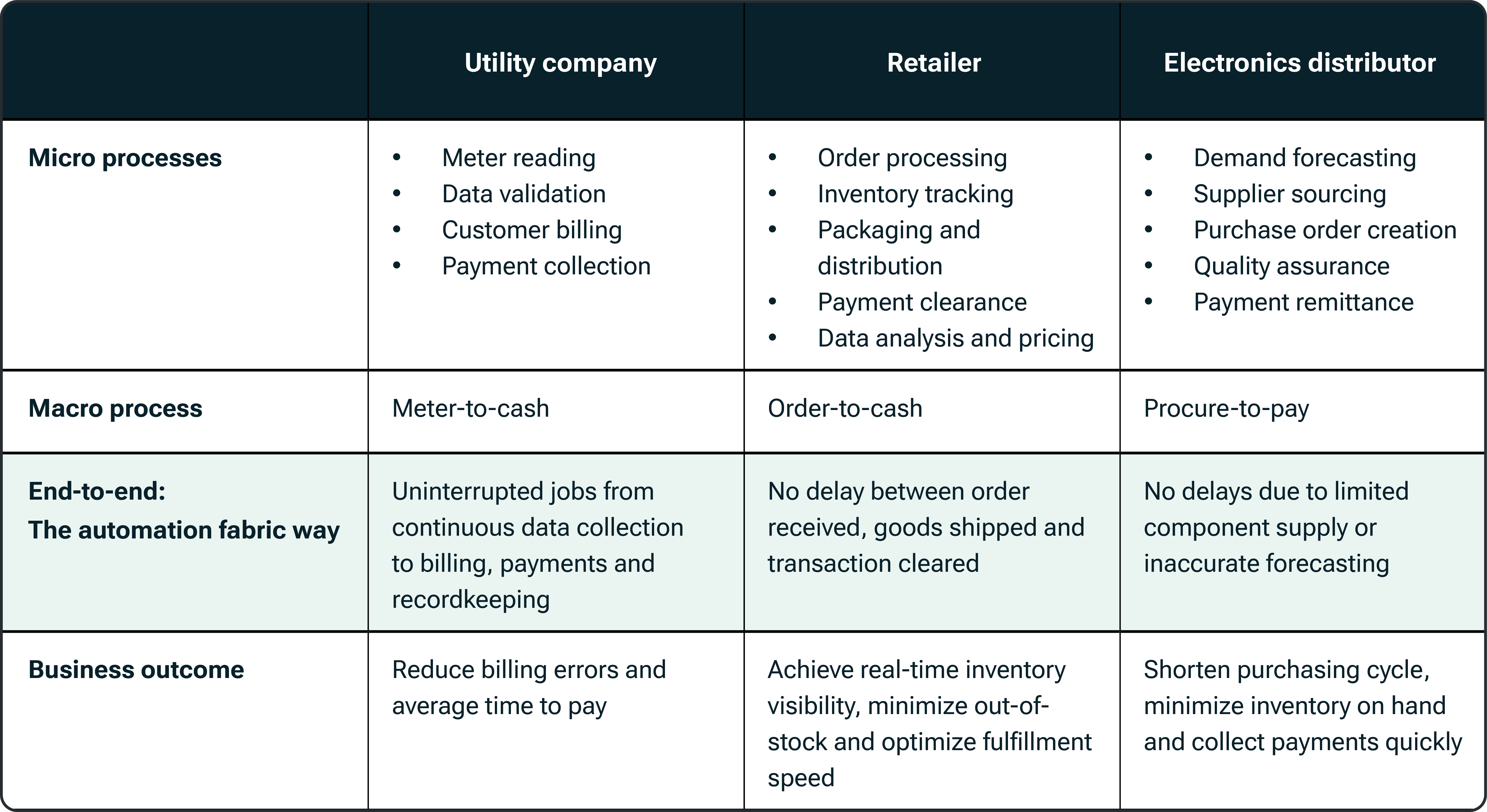Modernize or stagnate: How end-to-end business processes drive efficient growth

Enterprise operations are as complex as the systems of the human body. All departments and contributors must succeed in their distinct roles yet work together as a stable and consistent unit. Achieving efficiency within a complex structure — body or business — requires that every process be seamless from start to finish.
Given that more than 80% of global businesses are planning process automation initiatives, this moment in time is likely a crucial turning point in your business process automation journey. How should you go about developing and automating durable processes?
In this article, we’ll examine the process-related root causes of your less-than-optimal business outcomes and how to build a central nervous system in the form of end-to-end process automation that supports efficient growth.
What is an end-to-end business process?
To understand the difficulty of establishing a true end-to-end process, we should first align on what it is.
An end-to-end business process is a series of interconnected steps that collectively deliver a product or service. It encompasses all stages from initiation to completion and often requires coordination across multiple business units.
Examples of end-to-end processes in various verticals
Processes look different for different business functions, but in every instance, an end-to-end process closes a cycle or loop that must repeat from beginning to end.
Consider some industry-specific examples:
- A utility company automatically monitors usage across a network of meters in real time and collects data in a central control system. The billing department converts usage data into invoices based on current rates and leverages billing software to distribute invoices to customers. Customer service representatives address disputes. The payment processing team follows up on overdue accounts while the finance team records successful payments.
- A retailer receives goods from suppliers, sorts them in its warehouse and prepares them for dispatch to various retail outlets or directly to consumers. Logistics teams, warehouse staff and POS systems track and optimize the flow of goods to ensure a positive customer experience.
- A consumer places an order online or with an electronics distributor. An order management system captures details and initiates production planning and manufacturing. It checks inventory for raw materials, then sets into motion assembly line operations, quality assurance tests and packaging. Logistics then coordinates delivery while a finance team creates an invoice and processes payment. When payment is received, the process loop closes.
Barriers to constructing end-to-end business processes
While their repetitive nature may make them seem simple to set up, end-to-end processes are constructed from many micro processes that must happen in just the right order at just the right time. Overwhelmed by a volume humans can’t handle, technology solutions that fail to speak to one another and siloed functions, many leaders resort to building processes that fall short of end-to-end.
Human limitations
With any business process at scale, technology plays a starring role. Humans don’t have the time or capacity to complete as many tasks as are necessary to keep huge numbers of end-to-end processes flowing error-free. The sheer volume of data involved and the interconnectivity of modern enterprise systems require rapid decision-making and adaptation that outpace human reaction times. Bottlenecks are unavoidable and consistency is impossible when people are in charge beyond a certain critical growth stage.
Disjointed tech
Many organizations also grapple with legacy technological architecture. Outdated systems and a proliferation of applications, including some with cumbersome customizations, can’t keep pace with the process automation evolution. Fragmentation via isolated solutions creates data silos, prevents holistic analysis and may necessitate custom coding when you’re ready to automate across the entire tech stack. Even if your leadership team recognizes the negative impact of compartmentalized information, they might be reluctant to invest the effort and resources necessary to update or replace old technology to make end-to-end automation successful.
Instead of having a solution that’s only meaningful to and accessible by your IT or operations team, for example, you need a fully integrated automation layer that transmits signals like a nervous system to every corner of your business.
Siloed visibility
The most common kink in an enterprise process nexus is this reluctance, amplified — It’s people, not infrastructure. In most roles, you won’t inherently be aware of what everyone else in the organization is doing. It’s normal to focus on your responsibilities and fail to see the bigger picture. However unintentional, this leads to the acceptance of inefficiency across many departments and processes. What you can’t see, you can’t fix.
How the day-to-day drives outcomes
End-to-end automation requires a mindset shift. Instead of zooming in on micro processes your team takes part in and staying in that myopic state, imagine them rolling up into macro processes that span multiple business functions. When macro processes become uninterrupted from beginning to end, your desired outcomes are within reach. See the chart below for how properly implemented automation supports seamless operations.

Implement your business’s nervous system
Your personal nervous system drives your ability to move, think and respond to your environment. It’s a network of impulses that manages input and output across all systems of your body. If you’ve developed sufficient coping skills, such as breathing techniques or static stretching, you can better handle what life throws your way.
Similarly, an automation nervous system must integrate and monitor all functions to ensure minor stressors don’t disrupt operations. In an environment where you’re carrying out huge numbers of repetitive tasks per day (10,000+), all of them must take place on time and factor in complex dependencies for your larger, goal-driven end-to-end processes to work. Orchestrating these tasks via comprehensive business process automation is the only viable solution.
Components of an automation-driven nervous system
It’s not one person’s job to transition your business processes from disconnected and inefficient to unified and streamlined. It’s a strategic move by multiple process owners for the benefit of every stakeholder. To initiate and follow through on this change, your teams should be educated on the optimal infrastructure.
A well-functioning nervous system in business:
- is built on a tightly integrated foundation of enterprise-grade workload automation (WLA) and managed file transfer (MFT) solutions that support unencumbered mission-critical processes.
- connects your tech stack via an intuitive integration layer that reduces the need for and risk of workarounds or vulnerable endpoints.
- enables IT to swiftly and smoothly collaborate with all departments to drive success and adoption among business users.
- supports the design and development of entire processes at any scale and for any industry.
Large-scale business process management via automation
Automating critical business processes today is all about making it easier to design and develop those processes from end to end. With drag-and-drop interfaces, templates and automation wizards, you can strengthen your organization’s nervous system and establish resilience despite the volatility of the market — or the world.
Collaboration between IT and other departments is critical to successful automation initiatives. Traditionally, there has been a divide between technical experts and business users. Bridging this gap ensures that automations properly align with strategic objectives. An effective automation platform enables non-technical users while delivering the power and flexibility that IT professionals require.
A solution that connects a hybrid tech stack sans programming and scales easily without additional technical staff or human capital investment empowers your business to evolve and accommodate future processes and technologies.
Enterprise automation in practice: “No limits” for Journal Media Group
What does successful organization-wide automation look like? With RunMyJobs by Redwood, Journal Media Group knows from firsthand experience.
The company’s 35 radio stations, 13 TV stations and more than 20 newspapers and magazines across 11 US states keep its teams busy. In-house systems, multiple IT divisions and too many systems made it tough to confidently promise important business outcomes, such as delivering newspapers no later than 6 AM daily.
By migrating to cloud-based applications, eliminating manual steps and combining advertising, circulation and billing in one highly flexible environment, Journal Media Group discovered the benefits of a single solution. The business automated 30 in-house systems altogether. Data extraction and distribution are now complete by 5:30 PM each evening, allowing the team plenty of time to troubleshoot before morning delivery.
Achieve digital transformation and stay nimble with Redwood Software
Start building your organizational nervous system with a full stack advanced automation solution like RunMyJobs. Whether you choose an on-premise or cloud environment, RunMyJobs connects all your systems and data, provides end-to-end visibility and enables effortless automation creation.
Discover the power of a modern automation fabric — a connective layer that integrates all of your essential processes and enables unprecedented growth and innovation. Book a demo of Redwood’s solutions to explore the potential impact on your business outcomes.
About The Author

Jamie Herbstman
Jamie is Vice President of Product Marketing at Redwood Software. A seasoned executive with extensive experience in product marketing and business development in the technology sector, she leads a talented team focused on driving growth for Redwood’s automation software portfolio.
Before joining the Redwood team, Jamie founded her own successful consulting business, where she collaborated with leading tech companies such as Intuit, Facebook and eBay to support product growth and launch new offerings. Her studies in anthropology at UCLA, combined with her MBA from Harvard Business School, equipped her with the strategic insights and expertise to spearhead impactful marketing initiatives.
With a proven track record and a passion for innovation, Jamie is committed to elevating Redwood's product marketing efforts.